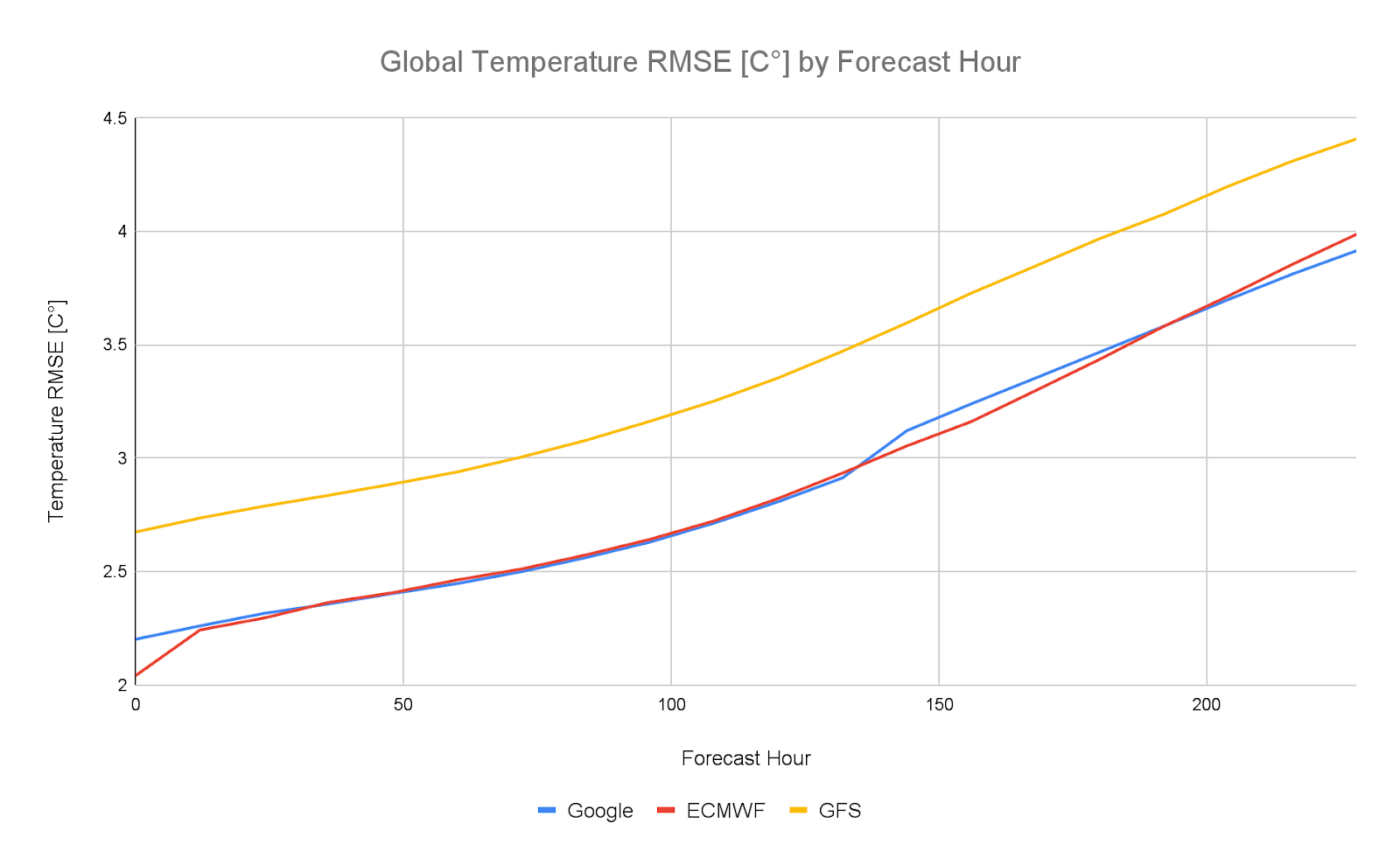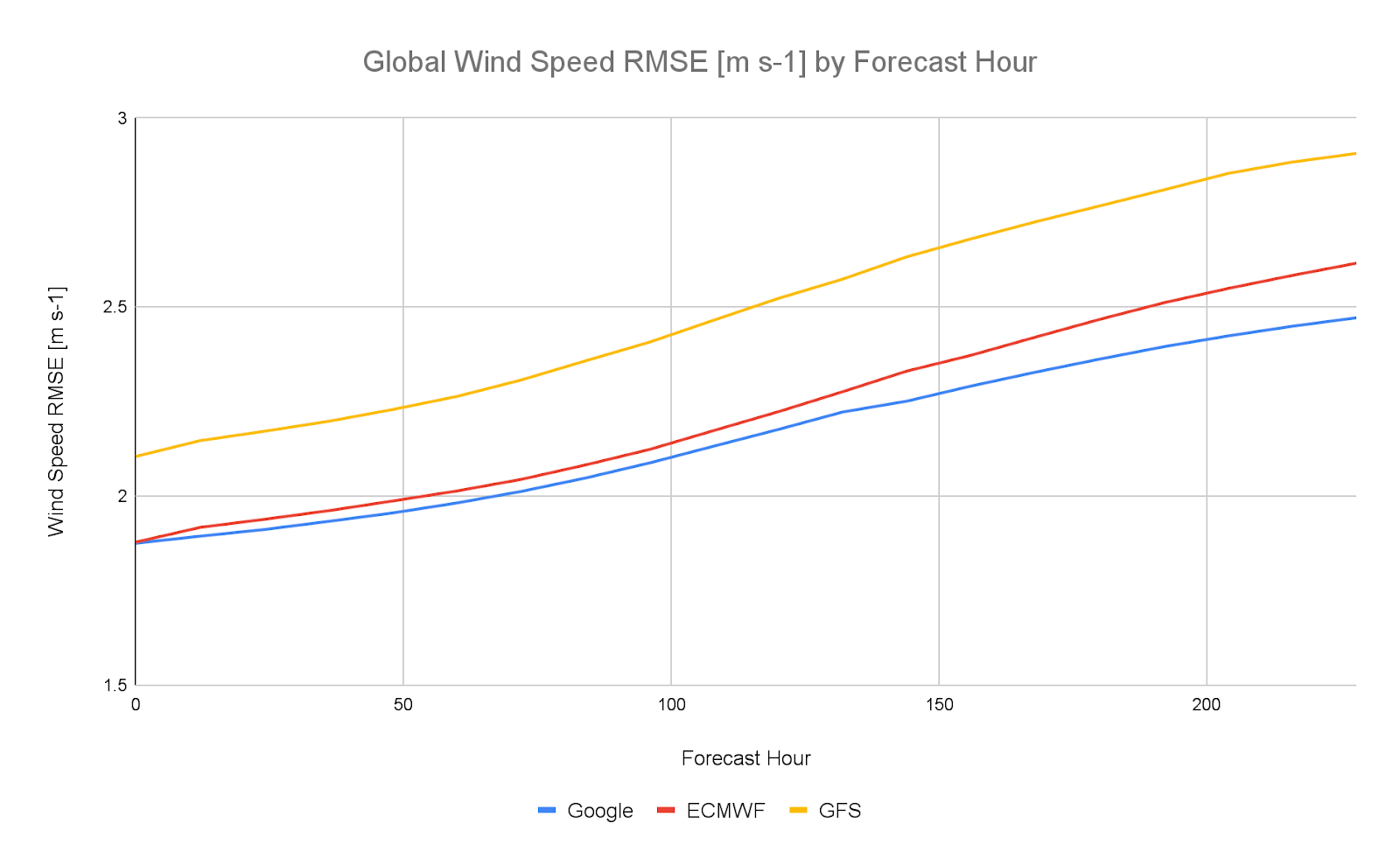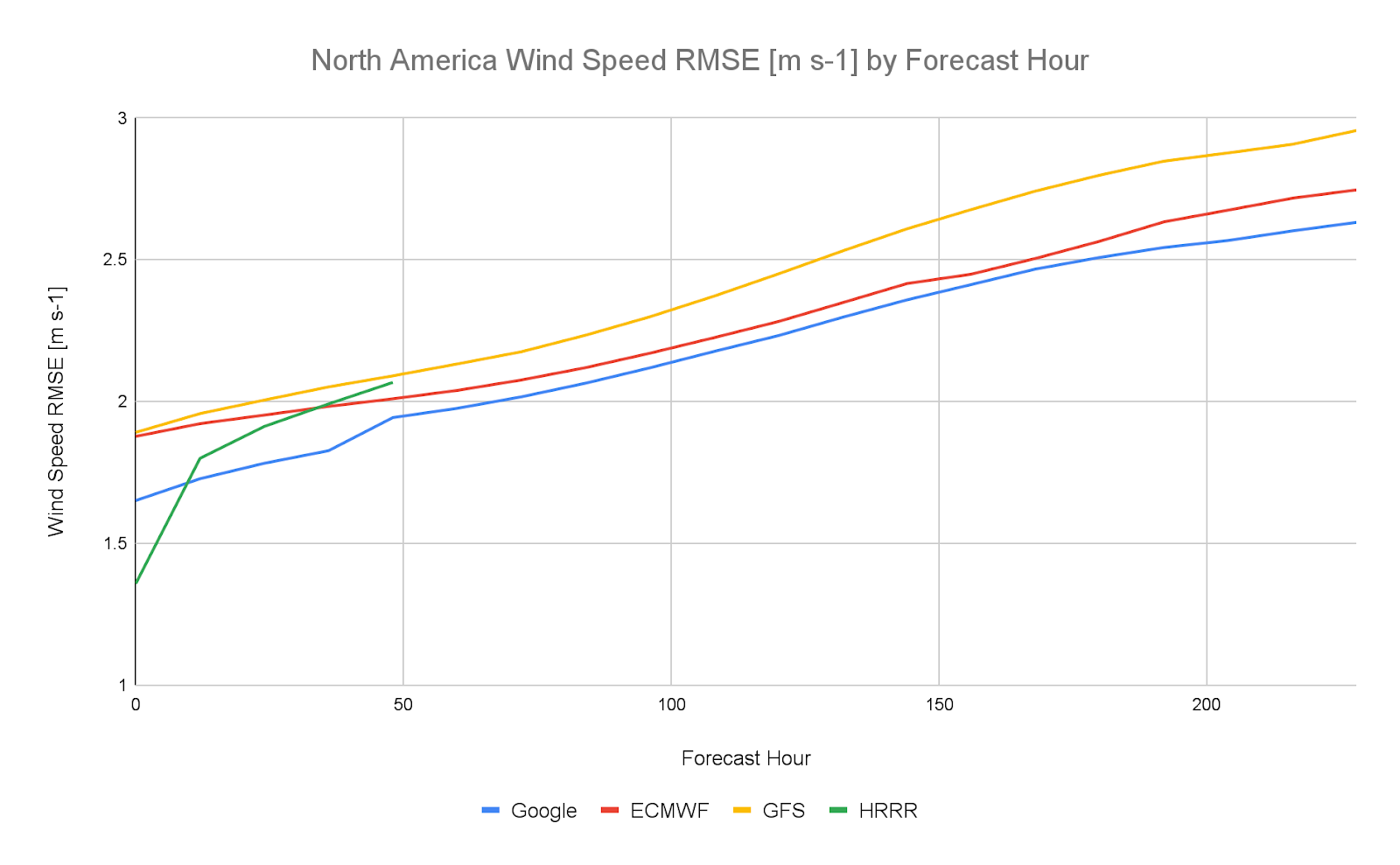General information
How would you differentiate Google's Weather API from specialized weather data vendors?
Google is integrating technology from our reputable weather company acquisition with advancements from Google DeepMind's MetNet and WeatherNext AI models (2025). This leverages the proven reliability of the Google Maps Platform.
What is the difference between weather data available in Earth Engine and BigQuery and Google's Weather API?
Google's weather product suite offers a comprehensive range of solutions for diverse needs. WeatherNext models (namely GraphCast and GenCast) provide raw, AI-based model forecast outputs including parameters ideal for research, modeling, and analysis, made available using open-source code and historical or current weather datasets using Earth Engine and BigQuery APIs.
Conversely, the Google Maps Platform Weather API delivers processed weather data for current conditions, hourly forecasts, and daily forecasts by combining AI and traditional forecasting systems in a developer-friendly format that seamlessly integrates into apps and web services. This dual approach caters to both specialized research needs and broad developer accessibility.
Why is Google not relying only on measurements from weather stations?
Google uses a variety of input sources for its weather model, including observations from weather stations, numerical weather prediction models, and weather AI models. The reason for using these various input sources is that observations from weather stations only provide information about the weather at the location of the station at the time of measurement. Weather station observations can be highly accurate for that precise spot, but weather phenomena such as precipitation, especially from showers or thunderstorms, is often localized and can vary significantly over a short distance.
For example, a heavy downpour might be occurring right at the station's location, while a few miles away, there's only a light drizzle or no rain at all. Because a single station reading might not be representative of a wider area, models are necessary to provide additional information in between stations.
Additionally, weather stations typically provide hourly or half-hourly readings. Even if those are provided in near-real time, there can still be a slight delay between the actual precipitation events and its reporting. Models also assist in getting the current conditions as close to the experienced reality at the queried location as possible.
API usage
What is the Weather API coverage?
The Weather API supports all countries globally except Japan, Korea, and prohibited territories. For our initial launch, we are supporting populated areas (excluding remote locations such as the middle of the ocean, deserts, and mountain tops). We are planning continuous resolution and quality improvements through 2025.
What is the spatial granularity of the Google Weather API?
Data resolution is such that forecasts are created within a few kilometers for any location globally.
What is the update frequency for the Weather API?
| Endpoint | Current conditions | Hourly forecast | Daily forecast | Hourly history |
|---|---|---|---|---|
| Refresh rate | 15 minutes (periodically within the hour) | 30 minutes (periodically within the hour) | 30 minutes (updated at the same time as hourly forecast) | Twice a day (7 AM and 7 PM Pacific Standard Time). |
Does the Weather API provide nowcast precipitation forecasting?
Google doesn't provide nowcast forecasting (minute forecast) in the API, but it does provide current conditions, hourly forecasts, and daily forecasts.
Does the Weather API provide separate UVA and UVB values?
UV Index is a single index which combines both UVA and UVB. We don't provide a breakdown by component.
How does the Weather API produce a forecast output?
As shown in the diagram below, Weather API forecasts are created from an internal forecasting system that utilizes weather models and observations from global weather agencies as inputs. Data from public ground-truth weather sensors are used to improve the forecast model.

What is the accuracy of the Google Weather forecast, for different regions and forecast horizons, compared with forecasts from leading government weather agencies?
The figures in Table 1 compare Root Mean Squared Error (RMSE) for temperature and wind speed for a 240 hour (10 day) forecast horizon between Google weather data and global and regional weather models from government agencies across 11 months (15 August 2024 through 1 July 2025).
Globally, the Google weather forecast outperforms weather forecasts from leading government agencies. For Europe and North America, the Google weather data has lower error than the most accurate regional government models for at least the later portion of their forecast horizons. The excellent performance of Google weather data for longer forecast horizons is particularly notable, which can be the most challenging to accurately predict.
Table 1 lists the average RMSE values for the entire forecast horizons relevant for each region model combination. A lower RMSE value indicates better performance. The Google weather forecasts have the lowest, or among the lowest average RMSE values, for nearly all parameters, regions, and forecast horizon ranges.
Click an image to view an enlarged version.
| Temperature | Wind speed | |
|---|---|---|
| Global |  |
 |
| North America |  |
 |
| Europe |  |
 |
Table 1. Average RMSE values for relevant for each regional model combination
Table 2 lists the average RMSE values for relevant forecast horizons for each model (Google values in bold). Parameters (temperature, wind) and forecast horizons for which Google uniquely has the lowest average RMSE are highlighted in dark green. Parameters and forecast horizons for which Google has the lowest average RMSE along with (an)other model(s) are highlighted in light green.
 Table 2. Average RMSE values for relevant forecast horizons per model
Table 2. Average RMSE values for relevant forecast horizons per model
Does the historical data endpoint reflect actual weather data (i.e., verified by local measurements)?
Historical weather data is primarily modeled output. While it incorporates observations from global weather agencies and numerical weather prediction (NWP) models, these are assimilated into the Google Weather model to create a complete and consistent historical record. Actual station measurements are considered "ground truth" at their specific locations, but their limited global distribution makes them insufficient for a complete worldwide picture.
What do the weatherCondition, precipitation.probability.percent, precipitation.qpf.quantity fields mean, and how are they related?
These fields provide distinct but related insights into precipitation and overall weather.
weatherCondition: This field provides a general, intuitive description of the overall weather conditions in the queried area, taking various parameters into account for easy understanding.precipitation.probability.percent(PoP): This represents the probability of precipitation. The likelihood that precipitation will occur at the location of the forecast during the defined time period (typically hourly).precipitation.qpf.quantity(QPF): This stands for quantitative precipitation forecast and indicates the expected amount of precipitation, measured as a depth (for example, millimeters or inches). This value represents how much precipitation is expected if it does occur within the specified time and location.
How can I determine whether or not it's raining at a certain location?
We recommend using the weatherCondition field in order to understand whether
it is raining or not at a certain location. Multiple conditions can indicate
that it is raining (RAIN, LIGHT RAIN, RAIN SHOWERS, HEAVY RAIN, WIND AND RAIN,
THUNDERSTORM, HEAVY THUNDERSTORM, THUNDERSHOWER, SCATTERED SHOWERS, LIGHT
THUNDERSTORM RAIN, SCATTERED THUNDERSTORMS, RAIN AND SNOW). These conditions are
designed to capture all instances of light, strong, continuous or scattered
rainfall and also differentiate rain from snow. Depending on your specific use
case — for example, if your use case only considers heavy rainfall — you may
choose to use only a relevant subset of these conditions.
Are the "current conditions" equivalent to the observations at weather station locations? How are "current conditions" determined in locations without stations?
Our "current conditions" provide the most up-to-date weather information by combining various data sources, but they are not strictly equivalent to direct station observations in all cases.
For precipitation.probability.percent and precipitation.qpf.quantity
(accumulated over the past hour), the value presented in the currentConditions
response is always derived from the most recent forecast. Probability itself is
a modeled, rather than directly observed, quantity.
This approach allows us to provide comprehensive "current conditions" even in areas without direct sensor coverage, ensuring the best available information at all times.
API limits and access
Is there a rate limit on the API?
For the Weather API, there is a default rate limit of 6,000 queries per minute.
Can I access the data in bulk?
Bulk data is not available. You can query Weather API within the quota (6,000 QPM) and respect caching terms outlined in the Terms of Service.
Do I have to enable billing?
A valid billing account is required to use the Weather API. See Enable billing to set up your project with a billing account.
What happens if I query a location that is not supported?
If the latitude and longitude are not covered in the supported country list, the response will return a 404 error code with the message, "Information is unavailable for this location. Please try a different location."
